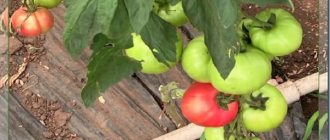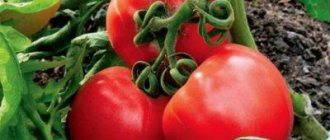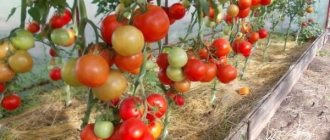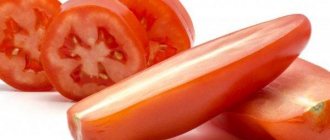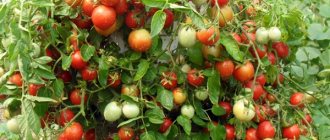Brief information about the variety
- Fruits : weight up to 140 g, pink color.
- Bush : determinate, height up to 70 cm.
- Productivity : up to 15 kg in open ground and up to 18 kg in protected ground. In the southern regions there are up to 3 harvests per season.
- Resistance : is immune to fungal diseases - late blight, alternaria and verticillium.
- Distribution : grown throughout Russia.
- Application : fresh and in salads, the fruits make delicious tomato juice; they are also used in canning and preparing pastes, ketchups, and sauces.
- Planting : sowing seeds for seedlings, germination after 10-14 days, further replanting to a permanent place in open or closed ground after 2 -2.5 months, planting in closed ground - 6-7 plants per m², in open ground - 5 plants not 1 m².
- Soil : fertile, drained, cultivated to a depth of 20 cm, medium in composition, weak acidity.
- Fertilizing : with mineral complex fertilizers 3 times a season, every 2-3 weeks.
- Watering : regular, sufficient, during the flowering period of the first two clusters - plentiful.
- Stepchildren : timely.
- Formation : stem and 3 brushes.
- Ripening period : from mid-July to September.
- Shelf life : until December in a cool, dark place.
Further care
Plants need to be watered with warm water.
Caring for the Duchess of Taste tomato comes down to loosening the soil, watering and fertilizing.
Loosening the soil is necessary if the soil is heavy. This helps saturate it with oxygen, which allows the root system to develop better. Hilling is carried out every 2 weeks.
Tomatoes need to be watered systematically. The procedure is carried out in the evening with warm water at the root of the plant.
Important stages of development and growth are the flowering of the first 2 clusters. At this time, abundant watering is required.
It is necessary to ensure that there is no stagnation of water and the soil is not waterlogged.
Feeding is carried out 3 times per season.
- 2 weeks after planting the seedlings in the ground, feed them with organic fertilizer.
- After another 2-3 weeks, the second and third fertilizing with mineral fertilizers is carried out.
The second feeding is carried out at the beginning of flowering with a complete mineral fertilizer containing nitrogen, phosphorus and potassium, for example Nitrophoska. The third feeding is carried out during fruit formation with phosphorus-potassium fertilizers.
Tomatoes need to be pinched and tied up in a timely manner.
Description of tomato variety Duchess of Taste
The bushes of the early-ripening determinate tomato Duchess of Taste are medium-sized, reaching 0.5-0.7 m. The stems are strong, the tops end in inflorescences, the stepsons appear from the axils of the lower leaves. The tap root system of a medium-leaf bush has many small shoots that supply it with food. The leaves are tomato-type, oblong, wrinkled, light green. The first inflorescence begins to form after the 6th leaf, the next ones are laid after 1 leaf. On one simple cluster of the Duchess of Taste hybrid, from 4 to 6-7 fruits ripen.
The seed manufacturer recommends cultivating the Duchess of Taste hybrid in open gardens or in greenhouses on private plots. For 2 sq. m place up to 5 bushes of a productive hybrid.
Description of plants
Duchess of Taste is not a very well-known variety. But this is not because it is bad, but because it is completely new - all tests ended only in 2022, at which time the variety was included in the register of varieties that are suitable for cultivation in the Russian Federation. “Domestic” origin is a huge plus for gardeners. Such varieties do not need additional adaptation; they feel good and take root more easily, since they do not undergo acclimatization.
In terms of ripening time, these tomatoes can be classified as early or even very early - judge for yourself, from the moment the first shoots form until the first fruits ripen, usually only 80 days pass, that is, less than three months. The bushes are small in size, the plants are rather low-growing - usually the height of one bush is about 70 centimeters. Duchess of Taste is a determinate variety.
The branches are covered with foliage. The shape of the leaves is classic for tomatoes, but oblong. Each cluster of bush can have from four to seven tomatoes.
It is recommended to grow tomatoes of this variety in open ground - they are excellent for this. But as practice shows, the Duchess of Taste grows very well in a greenhouse and can produce a much larger harvest.
Bush
The plant is determinate, low. The average height of the bush is about 70 cm. The leaves are oblong. Inflorescences appear after 6 leaves and there are up to 5 of them. in the ovary. What is typical for this variety is that all stems end in inflorescences, and subsequent stems appear from the axils of the lower leaves.
The root of the plant is well developed. It penetrates quite deeply into the ground, which allows it to receive more nutrients.
The deep root of the plant indicates that it has the ability to withstand drought and extract water from deep soil horizons. But the deeper the soil horizons are, the less nutrients they contain. The accumulation of nutrients comes from above, due to the decomposition of organic residues.
Fruit
The tomatoes are small, with an average weight of up to 140 g. The shape is round with a slight flattening. When ripe they are pink in color.
According to the description of those who have tried these tomatoes, their taste is sweet, not sour.
Due to these taste characteristics, the fruits are classified as a salad type and are recommended to be eaten fresh. They have thin skin and fleshy flesh.
On a bush in one brush it can grow up to 5-6 pieces. The harvest is easy to grow and retains its quality for a long time during transportation.
Description of fruits
The declared fruit weight of the Duchess of Taste tomatoes is up to 350 g, but more often gardeners harvest fruits weighing 120-140 g. Round, slightly flattened tomatoes with smooth skin are sometimes ribbed, but more often with a smooth surface. The skin is intensely pink, as is the flesh. The stalk has no green spots. Gardeners like tomatoes for their juiciness and mild taste. The seed chambers are located closer to the walls, 4-6 pieces per tomato. The core consists of dense pulp. The thin skin is also dense and resistant to cracking.
Characteristics of tomato Duchess of taste
A productive plant must have a large area for nutrition. For 1 sq. m of greenhouse soil, three bushes of determinate tomatoes are usually planted. Plants are placed less frequently in the beds - 5 per 2 square meters. m.
Disease resistance
With good care, tomatoes rarely get sick.
According to the characteristics, the hybrid is unpretentious in care, it tolerates heat and waterlogging of the soil well. It is distinguished by high resistance to fungal diseases, such as:
- late blight;
- Alternaria blight, when brown spots appear on the leaves;
- verticillium; The causative agent of the disease is in the soil and the young plant is infected through the root system.
has developed a disease-resistant variety, but don’t forget about prevention. It is advisable to spray tomatoes with fungicides, for example, Bordeaux mixture to combat fungal diseases.
Growth and maturation
A wonderful hybrid. We tested it at our experimental site. He showed very good performance. Early variety. About 100 days later we already started to see the first fruits. We have already collected them. This is already like a second harvest.
The bushes are determinate, that is, with limited growth. Height is approximately 60-70 centimeters. The fruits are medium in weight, somewhere around 130 grams. The clusters are simple, with 4-7 fruits per cluster. And you see how well they are developing, they have gained good mass. Round, slightly flattened, 152 grams. Normal weight, very good.
If we grow in a greenhouse, we grow 3-3.5 pieces per square meter. This means we plant 6-7 plants per 2 square meters. If we grow them in open ground, we plant about 5 pieces per square meter. It is clear that there they will be a little shorter in stature, and maybe even like that. It depends on what kind of care you give them.
Tomato productivity Duchess of taste and fruiting
The ripening period for tomatoes of the early-ripening hybrid Duchess of Taste is 85-90 days. The average yield per bush is from 12 to 16 kg of tomatoes in open beds, in closed ground it reaches 17-18 kg. A good harvest happens with the right agricultural technology:
- temperature comfortable for tomatoes is 23-27 °C;
- absence of sharp changes between day and night atmosphere;
- regular watering and constant feeding;
- prevention against fungal and viral diseases.
Important! Breeders of the Duchess of Taste tomato have achieved the ideal balance between the consistency of the tomato and its taste.
Advantages and disadvantages of the variety
New generation tomatoes have special properties. Hybrid plants have shown in practice their high positive qualities.
Uniformity of fruits is a distinctive quality of the hybrid
pros
- stable high yield from the bush;
- pleasant sweetish taste;
- excellent commercial properties - uniformity, attractiveness of the fruit;
- universal purpose;
- good keeping quality and preservation;
- drought resistance;
- ability to grow in soil with slightly increased acidity.
Nuances of agricultural technology
The Duchess of Taste is a hybrid. Therefore, no one will be surprised by the fact that the variety is unpretentious in care:
- The crop can be grown both in greenhouses and in open ground. There is not much difference, but in a greenhouse the yield may be higher.
- Young seedlings do not like the sun - it is better to cover the tomatoes for several days immediately after planting.
- Tomatoes love mulching - if you cover the soil around the roots with straw or spruce needles, it will be easier to control the moisture level.
- Tomatoes, like any other plants, do not like too much or infrequent watering. Make a plan and stick to it - you need stability with this strain.
- Despite the fact that the variety is considered very resistant to diseases, I still recommend taking preventive measures. Spray the bushes periodically with some product.
- During particularly dangerous periods - flowering, ripening, harvesting - feed the Duchess of Taste. She will be grateful to you.
Rules for growing seedlings
Seeds begin to be sown 2 months before planting in a permanent place.
Select soil that is drainable, light and low in acidity. This is achieved by mixing soil with ash or crushed eggshells.
Ash and eggshells are used by amateur vegetable growers to deoxidize the soil. But the soil for seedlings should initially be neutral.
Small depressions are made in the ground where the seeds are placed, watered carefully and covered with damp soil. The top of the box with seedlings is covered with polyethylene. When the sprouts appear, the film is removed. At the initial stage of seedling development, sufficient lighting is required. If there is little natural light, then add phytolamps.
Seeds germinate in 5-7 days. Plant the seedlings at the stage of two true leaves.
Sowing seeds for seedlings
To grow Duchess of Taste F1 tomatoes, only seedlings are used. Preparation of seedlings begins 50 - 60 days before planting in the ground.
To sow Duchess of Taste F1 seeds, take small containers that must be disinfected with hot steam or boiling water - plastic jars, seedling cassettes, etc. The soil must be air- and moisture-permeable, fertile. You can buy a ready-made universal substrate or mix a composition of the following ingredients in equal parts:
- humus;
- turf;
- sand.
The mixture is sifted through a sieve - no large stones or debris should remain. Then steam for two hours in a water bath. To feed the seedlings, add ash and finely ground egg shells (200 and 100 grams per 10 liters of soil, respectively).
When planting, the seeds are laid out on top of the soil, sprinkled 1.5 cm deep. The containers are covered with film until germination and transferred to a warm and dark place. To grow in peat tablets, place 1 - 2 seeds in each.
The higher the air temperature, the faster the sprouts appear. The film must be turned over periodically to remove any condensation that has formed. Shoots usually appear after 10 - 14 days.
Afterwards, the covering is removed and moved to sunlight - on a windowsill or under phytolamps. Seedlings should be exposed to light for at least 14 hours a day.
Tomatoes peak after two true leaves appear. 14 - 17 days before planting on permanent soil in a greenhouse or open soil, the seedlings are hardened off - taken out onto the street or open balcony, starting at two o'clock and gradually increasing the time.
Transplanting seedlings
The procedure is carried out after about 2-2.5 months, when the seedlings have grown and become stronger. Inflorescences are already possible on some stems.
The seedlings are transferred to a greenhouse or to a prepared place in the open ground. Approximately the size of a shovel, they dig holes for planting plants, and put nitrogen-potassium fertilizer in them.
You can use organic matter in the form of fluff or feathers from old pillows - this excellent nitrogen fertilizer nourishes the roots of a young plant and increases resistance to diseases.
In order for these fluff and feathers to become accessible organic substances, they must completely rot and decompose. This takes at least 5-7 months. Therefore, this technique does not have any positive effect on planted tomato plants.
Next, carefully remove the seedlings from the container and place them in the holes. Water it with warm water and carefully cover it with earth, pressing it down to remove air voids.
Since the tomato is low-growing, it can be planted close to each other. Approximate distance 30-35 cm.
It is advisable to plant seedlings in cloudy weather or shade the plants after planting.
Hermelin: features and rules for keeping the breed
The breed of dwarf rabbits Hermelin (Czech Hermelin) was bred by Western European breeders in the first half of the 20th century. Such a rabbit is often called an ermine, an ermine or a Polish rabbit, obviously due to the fact that the breed spread throughout Europe from Poland. Hermelin was the result of crossing albinos, wild rabbits, small silver and Dutch rabbits. These animals are difficult to confuse with rabbits of other breeds - Hermelins are always white in color, since their claws, skin and fur are not colored with pigment. A very impressive and cute decorative rabbit that resembles a toy in appearance.
Description and breed standard
- exclusively white coat color;
- eye color - blue and red;
- weight - 800-1500 grams (ideally 1.3 kilograms);
- ear length - 4.5-7 centimeters (ideally 5.5 centimeters), erect ears, beautifully shaped, with good hair, closely spaced;
- compact body shape, without a visible neck segment;
- short and large head;
- short front legs;
- a small tail that fits tightly to the back.
You can see good representatives of this breed in the photo at the bottom of this page.
How to choose a good rabbit
It mistakenly seems that all Hermelins are exactly the same, moreover, these rabbits have only white coat color. A good Hermelin fits the following description: a stocky, small, tightly built snow-white animal with a wide forehead and short ears. The shape of the head is round, the neck is practically not expressed. The ears are the main aspect when choosing; they should be small, round, and close set. Ears that are too fleshy, long or pointy are considered a defect. Short front legs and colorless claws are required.
A healthy rabbit is cheerful, lively and active. The eyes are clean and bright, without discharge, slightly moist. The nose is slightly wet or dry, breathing is calm. The coat is thick, shiny and clean. In order not to buy a bad Hermelin or a crossbreed, it is best to visit an existing nursery where they breed this breed and choose the animal you like.
Maintenance and care
Hermelin rabbits are decorative animals that are kept at home. And here, first of all, special attention should be paid to hygiene. Cages for rabbits must be made of galvanized mesh and must be equipped with pallets. The tray must be cleaned every day, washed, and disinfected. If the cage is not equipped with a tray, then deep litter is placed on the floor of the cage, which is changed every three days. Neglect of hygiene rules, in most cases, leads to acute infectious diseases in rabbits, which can be fatal. For example, such as coccidiosis (damage to the liver and digestive tract of an animal by coccidia), which cannot be treated at all.
Rabbits are nocturnal and at the same time rather timid animals. Therefore, during the period of their daytime rest, it is best to equip the cage with a portable plywood or wooden house. An important condition for keeping rabbits is direct sunlight, which promotes the production of vitamin D in the animal’s body, which is especially important for pregnant rabbits. If there is such a possibility, then the cage with the rabbit should be placed in the sun, but for no more than 1-2 hours.
Combs, slickers and tangle cutters are suitable for hair care. The matted fur must be carefully cut off with scissors or a special knife. Bathing rabbits is strictly not recommended. Nails should be trimmed as they grow (once every 4-6 weeks).
And the last one is feeding and watering the rabbits. Since the basis of the rabbits’ diet is succulent food, they consume most of the water from this. Therefore, they do not require large, open drinking bowls, in which the water stagnates and becomes polluted. The best option is drip drinkers, into which it is easy to add water-soluble vitamins and premixes, and they are easy to maintain. The same applies to feeders for concentrated feed (grain, mixed feed). Instead of open feeders, it is best to use hopper feeders. The norms for providing succulent feed must be strictly regulated. If they remain in the cage after feeding, they should be removed and not used again. Both succulent and concentrated feeds should be varied and introduced into the animal’s diet gradually.
In conclusion, I would like to say that the best way to preserve the life and health of your pet is care and attention. Therefore, if you notice something unusual and alarming in your rabbit’s behavior, contact your veterinarian immediately.
Video with a Hermelin rabbit at home
Video about how hermelin behaves when released from a cage at home.
Briefly about the main thing
- Duchess of Taste tomatoes are a new variety that was released only in 2022. It has excellent reviews from gardeners and has gained fame as very good.
- The plants are small but strong. They take root well in the ground and grow quickly—the variety is classified as a very early variety.
- The fruits are small and suitable for a variety of culinary uses. They taste very good, meaty and juicy.
- It is unpretentious in agricultural technology; the variety can be grown both in a greenhouse and in open ground.
Reviews from gardeners
Marina
I’m frankly always afraid of hybrids - it’s not clear what to expect from them, maybe some kind of peculiarity will come out... But then I decided to take a risk, my sister from the neighboring region was very praising it. I tried it and did not regret it - the tomatoes are very tasty, beautiful and store well. This year I don’t even plan to plant others - why, if you can just take the Duchess of Taste and use it in salad, juice, and for canning?
Basil
The yield of these small bushes is amazing! No, seriously, how is this possible? I spend little time on tomatoes, maybe even too little, but they produce at least 10 kilograms from one bush - I’m surprised. At the same time, the fruits are of excellent quality; I sometimes store them for several weeks. I'm pleased with the appetizing appearance and beautiful shape - my grandchildren eat, but they are capricious.
I’m actually a farmer, so we decided to try planting a hybrid this year as an experiment. I was surprised by the result - the yield is excellent, the bushes do not get sick and generally require minimal attention. I liked the fruits and their transportability - even transportation along a terrible road does not create a lot of waste. In general, I recommend the variety, you won’t regret it.
Tomatoes are one of the most common crops grown by amateur gardeners in our country. Since the Russian climate is not suitable in all regions for cultivating tomatoes in open ground, among the many varieties and hybrids, those that grow well in such conditions are especially valued. These types include the Duchess of Taste tomato, which has become widely known relatively recently.

